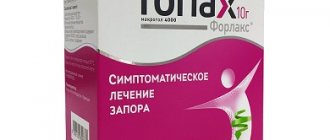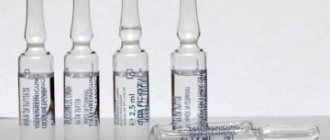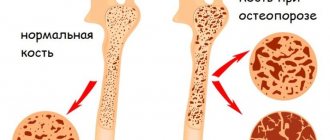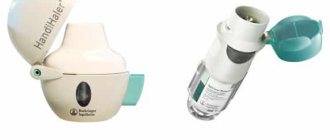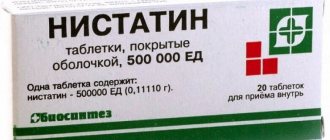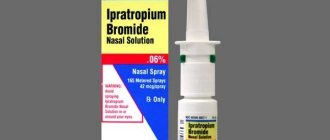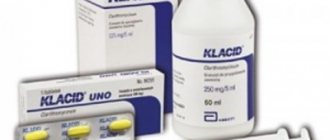The pharmaceutical drug Tramal belongs to the group of opioid analgesics. It has an analgesic effect, which is due to its effect on opioid receptors in the central nervous system. In addition, after consuming the medication, a sedative effect is provided.
Group: pharmaceutical drugs
When taken in therapeutic doses, hemodynamic parameters practically do not change, and respiratory depression does not occur. If you follow the dosage prescribed by your doctor, the risk of drug dependence is minimal.
Release form and composition
Tramal is available in the following forms:
- injection. Transparent, colorless liquid is bottled in glass ampoules (type I) of 1 or 2 ml. Ampoules are in blister packs (5 pieces each) and cardboard packs (1 pack per pack);
- rectal suppositories. Yellowish-white candles of a classic shape with a homogeneous structure, practically odorless, diameter - about 10 mm, length - 26 mm. Suppositories are packaged in cell-free contour packages of 5 pcs. and cardboard packs (1 package per pack);
- capsules. The elongated hard gelatin capsules consist of an opaque green cap and an opaque light yellow body and are equipped with a Snap fit (Coni-Snap®) closure. The Grünenthal logo is printed on the cap and body in black. Inside the capsules there is a fine, light yellow or white, odorless powder. Capsules are packaged in blisters of 10 pcs. and cardboard packs (2 blisters each);
- drops for oral administration. A low-viscosity, transparent, light yellow or colorless liquid, with a characteristic aroma of peppermint and anise, is bottled in 10 ml dark glass bottles equipped with a dropper. The bottles are packed in cardboard packs (1 piece per pack).
Contains 1 ml solution for injection:
- active ingredient: tramadol hydrochloride – 50 mg;
- excipients: water for injection, sodium acetate trihydrate.
Contains 1 rectal suppository:
- active ingredient: tramadol hydrochloride – 100 mg;
- excipients: vitepsol E 75, vitepsol W 35.
1 capsule contains:
- active ingredient: tramadol hydrochloride – 50 mg;
- excipients: magnesium stearate, sodium carboxymethyl starch, microcrystalline cellulose, colloidal silicon dioxide;
- shell composition: indigo carmine, iron oxide yellow, titanium dioxide, gelatin, sodium lauryl sulfate, iron oxide black, Capsugel ink 1028 black.
Contains 1 ml drops for oral administration:
- active ingredient: tramadol hydrochloride – 100 mg.
- excipients: glycerol 85%, potassium sorbate, sodium saccharinate, sucrose, sodium cyclamate, propylene glycol, macrogol glyceryl hydroxystearate, artificial anise flavor, partially dementholized peppermint leaf oil, purified water.
Contraindications
- epilepsy not amenable to drug control;
- acute poisoning with analgesics, alcohol, sleeping pills or psychotropic drugs;
- simultaneous use of MAO inhibitors, as well as a two-week period from the moment of their discontinuation;
- drug withdrawal syndrome;
- pregnancy;
- children's age (injection solution and drops for oral administration - up to 1 year, capsules and suppositories - up to 14 years);
- severe renal (creatinine clearance less than 10 ml/min) and liver failure;
- hypersensitivity to opiates or any components of the drug;
- for drops for oral administration - rare hereditary diseases that are accompanied by malabsorption of glucose and galactose, fructose intolerance, isomaltase and sucrase deficiency.
Tramal is taken with caution in the following cases:
- drug addiction (including opioid addiction);
- traumatic brain injuries;
- disturbances of consciousness of unknown etiology;
- state of shock;
- breathing disorders and disruption of the respiratory center;
- increased intracranial pressure;
- drug-controlled epilepsy;
- increased convulsive readiness;
- severe intolerance to opioids of non-allergic and allergic origin;
- the patient's tendency to develop drug dependence and drug abuse.
Directions for use and dosage
Injection
Tramal in the form of an injection solution is used for intramuscular, intravenous drip, intravenous jet and subcutaneous administration. With the intravenous method, the drug is diluted additionally in an injection solution and administered drip-wise or slowly.
The recommended dose of Tramal depends on the individual sensitivity of the patient and the severity of the pain syndrome. For chronic pain syndrome, the drug should be administered in accordance with a specific schedule.
- For children 1–12 years old, a single dose is 1–2 mg per 1 kg of body weight. It is necessary to select the minimum effective dose. The maximum daily dose of tramadol is 400 mg per day or no more than 8 mg per 1 kg of body weight (calculated based on the lowest value).
- For children over 12 years of age and adults, a single dose is 1–2 ml (50–100 mg of tramadol). In the absence of a satisfactory analgesic effect after 30–60 minutes. after the first injection, repeated administration of 1 ml of solution (50 mg of tramadol) is possible.
The initial dose of Tramal for severe pain is 2 ml (100 mg tramadol).
The concentration of the diluted solution for administration is calculated as follows:
- 5 mg tramadol per 1 ml: 1 or 2 ml injection solution + 9 or 18 ml added diluent;
- 5.6 mg tramadol per ml: 1 or 2 ml injection solution + 8 or 16 ml added diluent;
- 6.3 mg tramadol per 1 ml: 1 or 2 ml injection solution + 7 or 14 ml added diluent;
- 7.1 mg tramadol per 1 ml: 1 or 2 ml injection solution + 6 or 12 ml added diluent;
- 8.3 mg tramadol per 1 ml: 1 or 2 ml injection solution + 5 or 10 ml added diluent;
- 10 mg tramadol per ml: 1 or 2 ml injection solution + 4 or 8 ml added diluent;
- 12.5 mg tramadol per ml: 1 or 2 ml injection solution + 3 or 6 ml added diluent;
- 16.7 mg tramadol per 1 ml: 1 or 2 ml injection solution + 2 or 4 ml added diluent;
- 25 mg tramadol per ml: 1 or 2 ml injection solution + 1 or 2 ml added diluent.
To prepare the solution, you need to add the solvent to the ampoule with the drug. Unused solution is discarded.
Rectal suppositories
Adolescents over 14 years of age and adults are prescribed 1 suppository (100 mg of tramadol) 2 times a day (morning and evening). If the analgesic effect is insufficient, you can use 1 suppository (100 mg of tramadol) every 1–2 hours. The initial dose may be increased for severe pain.
After inserting the suppository, it is recommended to maintain a horizontal position for about 30 minutes.
Capsules
Tramal capsules are taken orally regardless of meals. It is prohibited to open or chew the capsules - they must be swallowed whole and washed down with plenty of liquid.
A single dose for adolescents over 14 years of age and adults is 1 capsule (50 mg of tramadol). If the analgesic effect is insufficient, you can re-take 1 capsule (50 mg of tramadol) after 30–60 minutes. For severe pain, the single dose can be increased to 2 capsules (100 mg of tramadol).
Drops for oral administration
Tramal in the form of drops for oral administration is taken regardless of meals with sugar or with a small amount of liquid.
The solution is in bottles with a child-resistant screw cap. To open the bottle, you need to press the cap firmly and then unscrew it. To remove the drug, turn the bottle upside down and lightly tap the bottom until the first drop appears. The cap must be screwed on tightly after use.
For children aged 1–12 years, a single dose should not exceed 1–2 mg of tramadol per 1 kilogram of body weight. The maximum daily dose of tramadol is 400 mg per day or no more than 8 mg per 1 kg of body weight (calculated based on the lowest value). When calculating the number of drops, it must be taken into account that 1 drop contains 2.5 mg of tramadol.
When treating children, a single dose of the drug depends on age and body weight:
- 1 year (body weight 10 kg) – from 4 to 8 drops;
- 3 years (body weight 15 kg) – from 6 to 12 drops;
- 6 years (body weight 20 kg) – from 8 to 16 drops;
- 9 years (body weight 30 kg) – from 12 to 24 drops;
- 11 years (body weight 45 kg) – from 18 to 36 drops.
For adolescents over 12 years of age and adults, 20 to 40 drops (50–100 mg of tramadol) are prescribed every 4–6 hours. If the analgesic effect is insufficient, repeated administration of 20 drops (50 mg of tramadol) is possible after 30–60 minutes.
The analgesic effect of the drug lasts for 4–8 hours (depending on the intensity of the pain syndrome). The daily dose of tramadol should be no more than 400 mg, however, in the postoperative period and during the treatment of cancer patients, doses may exceed the recommended ones.
For elderly patients (not older than 75 years) who do not have clinically significant renal or hepatic impairment, no dosage adjustment is required for any form of the drug. In patients over 75 years of age and patients with pathologies of liver and/or kidney function, the elimination of Tramal from the body may slow down, so the interval between doses of the drug must be increased.
It is necessary to select the minimum effective dose. The duration of treatment using the drug should not exceed the optimal one. Long-term use of Tramal implies regular monitoring of the patient’s condition, which will allow optimizing the duration of therapy and adjusting the doses used.
Reviews
- Galina, 46 years old. Treatment with Tramal was prescribed to relieve pain resulting from cancer. The effect, which is surprising, is sometimes different. In some cases, after the injection, a feeling of confusion appears, while in other situations the condition remains the same. Pain is eliminated reliably. Although occasionally I notice problems with breathing during inhalations.
- Vladimir, 31 years old. Tramal did not suit me at all. During use, I noticed a significant deterioration in respiratory function. It’s good that the treatment initially took place in a hospital setting and the medical workers provided the necessary assistance in a timely manner. Further treatment took place with other drugs.
Side effects
- nervous system: very often – dizziness; often – drowsiness, headache; rarely - epileptiform seizures (with high doses or simultaneous use of drugs that reduce the threshold of convulsive readiness), coordination problems, tremors, involuntary muscle contractions, speech disorders, paresthesia, fainting;
- cardiovascular system: infrequently (mainly with significant physical exertion or intravenous administration) - orthostatic hypotension or collapse, tachycardia, palpitations; rarely – increased blood pressure, bradycardia;
- respiratory system: rarely - shortness of breath, respiratory depression;
- digestive system: very often – vomiting, dry mouth, nausea; often – constipation; infrequently - flatulence, vomiting, diarrhea, feeling of heaviness in the epigastrium;
- urinary system: urinary disorders (urinary retention, dysuria);
- liver and biliary tract: isolated cases - coincidence of tramadol therapy with increased activity of liver enzymes;
- immune system: rarely - anaphylaxis, allergic reactions (bronchospasm, angioedema, shortness of breath, wheezing);
- musculoskeletal system: rarely – muscle weakness;
- metabolism and nutrition: rarely – changes in appetite;
- mental disorders: rarely - sleep disturbances, hallucinations, nightmares, confusion, delirium, anxiety, mood changes (usually euphoria, less often dysphoria), changes in activity (usually decrease, less often increase), impaired perception and cognitive functions, development of drug dependence;
- organs of vision: rarely - blurred vision, mydriasis, miosis;
- skin: often – sweating; uncommon – urticaria, rash, itching;
- general disorders: often – fatigue; rarely - the development of symptoms similar to opioid withdrawal syndrome (sleep disturbances, nervousness, agitation, anxiety, tremor, hyperkinesia, gastrointestinal symptoms); very rarely - paresthesia, tinnitus, severe anxiety, panic attacks, hallucinations, confusion, derealization, depersonalization, paranoia.
- other: increased sweating (especially with rapid intravenous administration); isolated cases - difficulty swallowing water.
special instructions
For patients with epilepsy and patients susceptible to the development of seizures, Tramal is prescribed only for health reasons.
The drug has a low potential for developing drug dependence, but its long-term use can lead to addiction, mental or physical dependence. Therefore, patients prone to drug abuse or developing drug dependence should take Tramal in short courses and be under medical supervision at this time.
The drug cannot be used for replacement therapy in patients with opioid dependence.
In studies in pregnant animals, very high doses of tramadol have been found to affect organ development, ossification, and neonatal mortality. Due to the lack of convincing evidence of the safety of the use of tramadol during human pregnancy (the substance is able to penetrate the placental barrier), the use of Tramal during this period is not recommended. Long-term use of tramadol by a pregnant woman can cause withdrawal syndrome in the newborn. The use of tramadol before and during childbirth does not affect uterine contractility during childbirth. This substance may cause changes in respiratory rate in newborns (not clinically significant).
Approximately 0.1% of the dose of tramadol administered to a nursing mother passes into breast milk, so Tramal should not be prescribed during lactation. A single dose of tramadol is not a reason to interrupt breastfeeding.
When treated with Tramal, you should stop driving moving machinery and vehicles.
How Tramal is used by drug addicts
Tablets and capsules of the drug are used by addicts to obtain euphoric sensations. Enterprising drug addicts use injection solutions to produce other psychoactive substances. After taking the drug, the effect is felt within 5 minutes, euphoria lasts approximately 1.5 days. A person feels unnatural emotional sensitivity, relaxedness and a surge of strength; he is ready to love and sympathize with everyone.
Signs of use and consequences
When used in therapeutic doses, there is no dependence on the drug, but if the dosage is increased, pathological treatment for the drug develops very quickly. If a person uses Tramal for about 3 months, then it becomes the only narcotic substance used. Quitting the use of medication is very difficult; breakdown products can take 20 years to be eliminated; overcoming psychological dependence can take up to 15 years.
If the addict fails to take the dose in a timely manner, painful withdrawal symptoms will begin to appear. These include:
- Depression
- Hallucination
- Irritability, aggressiveness
- Exhaustion of the body
- Pale skin
- Lack of appetite
- Cloudy eyes
Symptoms of addiction:
- Deceit, indifference, reluctance to communicate with family
- Violation of the usual level of activity
- Sleep problems
- Mood swings
- Hair loss
- Fainting
- Dizziness
It is almost impossible to cope with analgesic addiction on your own. At the first manifestation of pathological cravings, it is advisable to consult a doctor.
Drug interactions
The drug in the form of an injection solution is pharmaceutically incompatible with injection solutions of diazepam, indomethacin, diclofenac, midazolam, flunitrazepam, nitroglycerin, phenylbutazone.
Tramal should not be prescribed simultaneously with MAO inhibitors or within 2 weeks after their discontinuation. The interaction of these drugs can lead to the development of life-threatening manifestations in the cardiovascular, respiratory and central nervous systems.
When tramadol is used together with substances that suppress the activity of the central nervous system (including alcohol), adverse reactions from the central nervous system may increase.
Concomitant or previous use of Tramal and cimetidine (an inhibitor of microsomal liver enzymes) very rarely causes a clinically significant interaction. Previous or concomitant use of carbamazepine (an inducer of microsomal liver enzymes) may reduce the analgesic effect of tramadol and shorten its duration of action.
Tramal can cause convulsions, including due to the ability to enhance the effect of the following drugs:
- serotonin-norepinephrine reuptake inhibitors;
- selective serotonin reuptake inhibitors;
- neuroleptics;
- tricyclic antidepressants;
- mirtazapine, bupropion and other drugs that lower the seizure threshold.
Concomitant use of tramadol with other serotonergic drugs (serotonin-norepinephrine reuptake inhibitors, tricyclic antidepressants, selective serotonin reuptake inhibitors, mirtazapine, MAO inhibitors) may cause the development of serotonin syndrome. The likelihood of this reaction occurs in the presence of the following syndromes or symptoms:
- hyperreflexia and tremor;
- spontaneous muscle clonus;
- inducible or ocular myoclonus, which is accompanied by increased sweating or agitation;
- hypertension, increased body temperature (more than 38 ° C) and ocular or inducible myoclonus.
After discontinuation of serotonergic drugs, symptoms quickly disappear.
Patients taking Tramal and coumarin derivatives (for example, warfarin) simultaneously should be under close medical supervision. In patients in this group, the international normalized ratio (INR) may increase with the appearance of ecchymosis and bleeding.
Erythromycin, ketoconazole and other inhibitors of the CYP3A4 isoenzyme may slow down the metabolism of tramadol, and possibly also the active O-demethyltramadol. No studies have been conducted on the clinical significance of this interaction.
Based on limited data, it can be concluded that taking the 5-HT3 receptor blocker ondansetron before and after surgery increases the need for tramadol during the treatment of postoperative pain.
Analogs
If the use of Tramal is impossible for some reason, the doctor may prescribe a drug with a similar effect:
- Tramala retard;
- Tramadol Stada;
- Tramaclosidol;
- Plazodol;
- Tramolina;
- Tramalgina;
- Sintradona;
- Amadona long;
- Tradola;
- Tramagita and others.
When choosing an analogue, you should take into account that each product has some contraindications for use. Therefore, only the attending physician can replace the medication.
